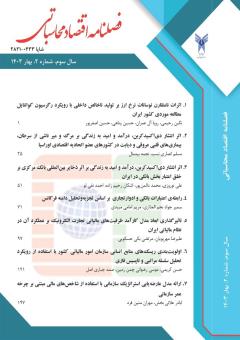اثر انتشار دیاکسید کربن بر مرگ و میرناشی از سرطان، بیماریهای قلبی عروقی، بیماری های مزمن تنفسی و دیابت زنان و مردان
محورهای موضوعی : فصلنامه اقتصاد محاسباتی
مسلم انصاری نسب
1
![]() ,
نجمه بیدمال
2
,
نجمه بیدمال
2
1 - دانشیار اقتصاد ولی عصر
2 - دانشجوی دکتری اقتصاد
کلید واژه: انتشار دیاکسید کربن, دیابت, بیماریهای قلبی- عروقی, کشورهای اوراسیا, روش پانل دیتا با گشتاورهای تعمیمیافته (GMM).,
چکیده مقاله :
یکی از مهمترین موضوعاتی که امروزه در رابطه با تغییراتی اقلیمی و افزایش مرگ ومیرهای ناشی از بیماری دیابت و بیماریهای مربوط به لیپیدهای خون مطرح است بحثهای مرتبط به آلایندهها به ویژه انتشار دیاکسید کربن است. این مطالعه توصیفی-تحلیلی و کاربردی حاضر با رویکرد اقتصاد کلان انجام شده که داده ها همگی از بانکجهانی استخراج شده است. در این راستا این پژوهش به بررسی اثر انتشار دیاکسید کربن بر افزایش سرطان، بیماریهای قلبی- عروقی و بیماریهای مزمن تنفسی و دیابت زنان و مردان در کشورهای عضو اتحادیه اقتصادی اوراسیا با استفاده از روش گشتاور تعمیمیافته (GMM) برای سالهای 2018-2000 پرداخته است. نتایج حاکی از این است که اثر درآمد بر میزان مرگومیر ناشی از این بیماریها در این کشورها بر زنان و مردان منفی و معنادار برآورد شده است. انتشار دیاکسید کربن اثر مثبتی بر افزایش مرگومیر مردان (020/0) ناشی افزایش سرطان، بیماریهای قلبی- عروقی و بیماریهای مزمن تنفسی و دیابت دارد درحالیکه این اثر بر میزان مرگومیر زنان (042/0) و دو برابر مردان برآورد شده است. بنابراین انتشار دیاکسید کربن یکی از مهمترین دلایل افزایش مرگومیر ناشی از سرطان، دیابت، بیماریهای قلبی- عروقی و بیماریهای مزمن تنفسی است لذا کنترل و مدیریت آلاینده-های زیستمحیطی را بیش از گذشته باید مورد توجه و اهمیت برنامهریزان و تصمیم گیران کلان قرار گیرد.
Extended Abstract Purpose One of the most important issues today related to climate change and the increase in deaths from diabetes and blood lipid diseases is the debate over pollutants, especially carbon dioxide emissions. Methodology The present descriptive-analytical and applied study has been done with a macroeconomic approach, all data of which have been extracted from the World Bank. This study examines the effect of carbon dioxide emissions on the rise cancer, cardiovascular disease, chronic respiratory disease and diabetes in men and women in Eurasian Economic Union countries using the Generalized Torque method (GMM) for years 2018-2000 is covered. Finding The findings suggest that carbon dioxide emissions have had a positive effect on increasing mortality due to increased cancer, cardiovascular disease and chronic respiratory diseases and diabetes. The effect of income (GDP variable) and life expectancy has had a negative impact in the period under review on total mortality rates, male mortality rates and female mortality rates. Conclusion The results indicate that pollution (carbon dioxide emissions) carbon dioxide emissions have a positive effect on the increase in male mortality (020/0) due to increased cancer, cardiovascular disease and chronic respiratory diseases and diabetes, while this effect has been estimated at twice the rate of female mortality (042/0) and twice the rate of male mortality and at a higher meaningful level of 95 percent. Perhaps the reason for this can be attributed to the physical elegance of women. Therefore, due to the high levels of pollutants in the air and the resulting health consequences, especially cardiovascular diseases, appropriate measures should be taken to reduce air pollution. On the other hand, the effect of income (GDP variable) has had a negative impact on the overall mortality rate, male mortality rate and female mortality rate. It is known that as economic growth increases in Eurasian member states, it causes income (GDP increase) in these countries, which improves the Human Development Index and health indicators of quality of life, resulting in a decrease in mortality. The variable effect of life expectancy on male and female mortality from cancer, diabetes, cardiovascular disease and chronic diseases was negatively estimated. So the more pollution increases, the more deaths from cancer, cardiovascular disease, chronic respiratory disease, and diabetes increase, which reduces life expectancy in these countries. So, the results of this study can be a good way for planners and decision - makers in large countries in the field of the effect of pollutants on the death of men and women from cancer, diabetes, cardiovascular disease and chronic respiratory diseases of member states, as well as controlling and managing environmental pollutants more than ever. Therefore, the following economic policies are proposed: economic policymakers such as the Ministry of economy and the central bank are proposed to adopt long-term plans to increase the country's income because increasing income will improve the financial situation of households and reduce deaths. The country's economic and health policy makers, especially the planning and budget agency and the Ministry of health, are advised to implement appropriate policies, especially to increase the umbrella of pension support and health insurance, to cover the costs of diseases such as cancer, diabetes, cardiovascular disease and chronic respiratory diseases, to promote life expectancy to reduce death. Environmental policy makers, especially the Environmental Protection Agency, the Ministry of Interior, standards and municipalities of the country, are advised to adopt appropriate policies such as improving public transport, improving the quality of domestic car engines, controlling and removing polluting industries from urban areas to reduce carbon dioxide emissions.


